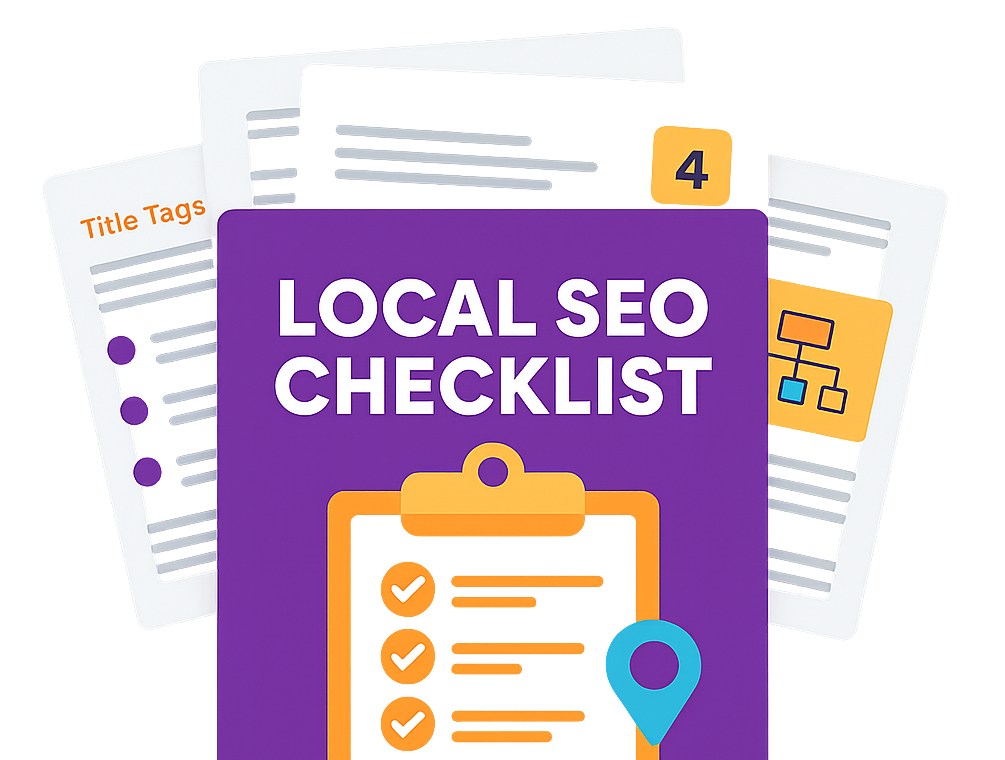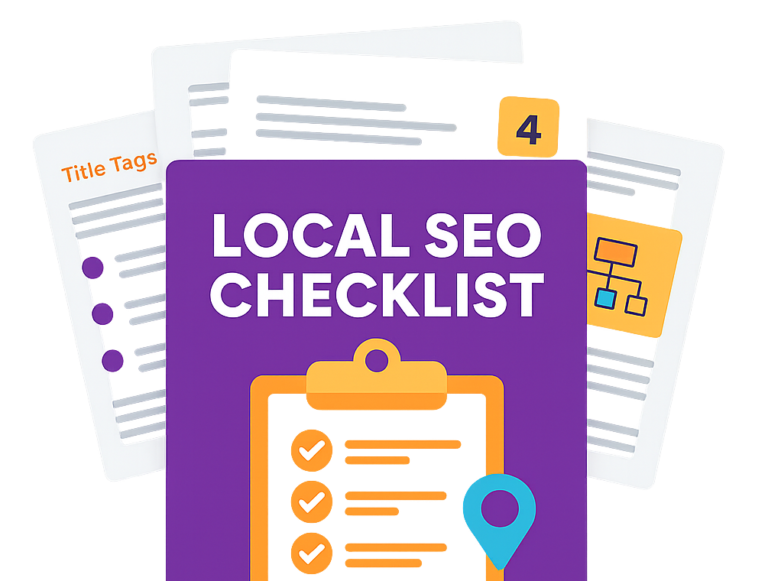Getting your website to rank higher on Google comes down to a few core principles: sorting out your technical setup, creating genuinely useful content, and earning authoritative backlinks. At the end of the day, you're trying to make it dead simple for Google to understand your site while proving to them that you have the best answers for people in the UK.
Building Your Foundation for Ranking Success
Before you even think about complex strategies, you have to get the basics right. Think of it like building a house – without solid foundations, everything you build on top is just waiting to come crashing down. In SEO, that foundation is a mix of technical health and smart on-page organisation. If you want to compete in the UK market, getting this part right isn't optional.
This all starts with making sure Google’s crawlers can find, understand, and index your content without a hitch. If they can’t, even the most amazing blog post you’ve written might as well be invisible.
The Bedrock of Technical SEO
Technical SEO is all the work that happens behind the scenes. It’s less about the words on the page and more about how the site is actually built. A huge part of this is your site architecture—how your pages are structured and linked together. A logical, clean structure is a win-win; it helps real users find what they need, and it helps search engines do the same.
Another absolute must-have is a mobile-friendly website. A massive chunk of searches in the UK now happen on phones, so Google heavily favours sites that work flawlessly on a smaller screen. If your website is a pain to use on a mobile, your rankings will absolutely feel the pinch.
A technically sound website isn’t a 'nice-to-have'; it's the price of entry for competing in search. Google rewards websites that are fast, secure, and easy to crawl because they provide a better user experience.
Finally, you need to be obsessed with your Core Web Vitals. These are specific metrics Google uses to judge the real-world experience of using your site, focusing on how fast it loads, how quickly it becomes interactive, and whether things jump around on the screen. A bad score here is a direct roadblock to improving your Google search rankings. For a proper deep-dive, our technical SEO audit checklist gives you a clear, structured way to check your site's health.
Uncovering What Your UK Audience Wants
Once your technical house is in order, it's time to figure out what your potential customers are actually searching for. This is keyword research, but it's much more than just finding popular terms. It’s about getting inside your customer's head and understanding their intent—the "why" behind their search.
For any UK business, this means thinking locally. A roofer in Cambridge shouldn't just be going after the term "roofer." They need to target phrases like "roof repair Cambridge" or "emergency roofer Cambridgeshire." Getting this specific brings in the right kind of traffic.
To get this right, you need to:
- Brainstorm your core topics: Start broad. What are the main things you do? For a local bakery, it might be "sourdough bread," "wedding cakes," and "local coffee shop."
- Dig for specific keywords: Use keyword tools to find long-tail keywords—those longer, more specific phrases people use when they're closer to making a decision. Instead of just "cakes," you might find "vegan birthday cakes delivered in Ely."
- Spy on your competitors: See what keywords your rivals are ranking for. You'll often uncover some golden opportunities you've missed.
The final piece of this foundational puzzle is mapping these keywords to specific pages on your site. Every important page should have a clear keyword focus. This ensures your content is perfectly aligned with what your UK audience is looking for, creating a rock-solid base for everything else you do.
Creating Content That Ranks and Converts
Once you’ve got a solid technical foundation, it’s time to focus on what really moves the needle: creating content that genuinely helps your audience and shows Google you’re an expert. High-quality, relevant content is the engine of modern SEO. We’re long past the days of just stuffing keywords onto a page. Today’s success is all about creating valuable resources that nail user intent and build your authority.
This means thinking less about individual keywords and more about building topic clusters. Picture a central "pillar" page—a really comprehensive guide on a broad subject like "small business accounting." Then, you surround it with smaller "cluster" articles that dive deep into specific subtopics, like "choosing accounting software" or "understanding VAT for SMEs." This kind of organised structure proves your depth of knowledge on a subject, making it much easier for Google to see you as a credible source.
Writing for Clicks and Engagement
Your content’s first real test happens on the search engine results page (SERP). Your title tag and meta description are your shop window, and they need to be compelling enough to win that click over your competitors.
Here's what a standard search result looks like, with these crucial elements highlighted.

As you can see, the title tag (the blue link) and the meta description (the grey text below) team up to give searchers a sneak peek of your page. This preview directly influences whether they click on your link or someone else’s.
To make these elements work for you, just follow a few simple rules:
- Be Clear and Specific: Your title tag needs to accurately reflect what the page is about and include your main keyword. For a local plumber in Ely, something like "Emergency Plumbing Repairs in Ely | 24/7 Service" is miles better than a generic "Plumbing Services."
- Write Compelling Descriptions: Think of the meta description as a mini-advertisement. Use active, punchy language and highlight a key benefit to draw the user in. For example: "Fast, reliable emergency plumbing in Ely. We fix leaks, blocked drains & boiler issues 24/7. Call for a no-obligation quote."
- Use Structured Headers: Inside your actual content, use clear headings (H2s and H3s) to break up the text. Not only does this make it easier for people to read, but it also helps search engines figure out the structure and importance of your information.
The goal is to create a seamless journey from the search result to your webpage. A compelling title gets the click, and well-structured, valuable content keeps the visitor engaged, signalling to Google that you've satisfied their query.
Building Authority with Internal Links
Internal linking—simply linking from one page on your website to another—is one of the most powerful and underused SEO tactics out there. A smart internal linking structure does three key things: it helps users find their way around your site, it spreads ranking power (link equity) across your pages, and it helps Google understand how all your content is related.
For example, if you've written a blog post on "The Benefits of Regular Boiler Servicing," you absolutely should link from that post to your main "Boiler Servicing" page. This simple action tells Google that the blog post supports your core service, strengthening the topical authority of both pages. To really get this right, you need to understand https://www.bare-digital.com/how-to-create-content-strategy/ that maps out these relationships from the very beginning.
In the UK, optimising for Google is non-negotiable. It holds a staggering 93.35% of the UK search engine market. This dominance means that getting your content aligned with its algorithms is everything. But there’s a new player in town: AI chatbots like ChatGPT now handle nearly 80% of AI chatbot traffic. This has introduced a new discipline called Generative Engine Optimisation (GEO), where informational queries often get answered before a user even clicks through to a website.
A modern SEO strategy has to account for this. You need to create content that not only ranks in traditional search but is also authoritative enough to be cited and used by these new AI tools.
Earning Authority with High-Quality Backlinks
Once your website is technically sound and filled with brilliant content, it's time to focus on building authority. In Google's world, one of the biggest signals of authority is backlinks—links from other websites pointing to yours.
Think of them as votes of confidence. The more high-quality votes you get, the more credible your site appears. But it's a classic case of quality over quantity. A single link from a well-respected UK industry blog is worth far more than hundreds of links from spammy, low-quality directories. The real goal is to earn links that feel natural and genuinely add value to the web.
Shifting Focus from Link Building to Link Earning
The best, most sustainable way to build a strong backlink profile is to create things that people actually want to link to. This flips the script from just asking for links to earning them organically, simply because your content is the best resource out there.
Here are a few proven ways to create these "linkable assets":
- Original Research and Data: Run a survey, analyse industry data, or pull together unique statistics for your UK audience. When you become the original source of information, other bloggers and journalists will naturally link back to you when they cite your findings.
- Comprehensive Guides and Tutorials: Create the definitive "how-to" guide for a common problem in your field. If your guide is more detailed, better explained, and more up-to-date than anyone else's, it becomes the go-to resource that people reference.
- Free Tools and Templates: Develop a simple calculator, a handy checklist, or a useful template that solves a real problem for your audience. Practical tools are incredibly shareable and attract links from all sorts of websites.
When you focus on creating this kind of value, the whole link-building process feels much more natural. You're not just asking for a favour; you're offering something genuinely useful.
Proactive Strategies for Acquiring Quality Links
Creating fantastic, linkable assets is a great long-term play, but you can't just sit back and wait. To really compete, you need to be proactive. This is where strategic outreach comes in, but it has to be done thoughtfully.
One of the most effective tactics is guest posting. This is where you write an article for another reputable website in your niche. In return, you usually get a link back to your site, either in the content itself or in your author bio. The trick is to target websites that are relevant to your industry and have a real, engaged UK readership.
A great guest post isn't just about grabbing a link. It’s a chance to provide real value to a new audience, establish your expertise, and build relationships with other site owners in your field.
Digital PR is another powerful method. This involves creating newsworthy stories or data and pitching them to journalists and publications. For example, a Cambridgeshire estate agent could release a report on local house price trends and share it with regional news outlets. If they pick up the story, you'll earn highly authoritative backlinks.
For a more detailed breakdown of these tactics, our guide offers practical advice on how to build backlinks that actually move the needle.
Identifying and Avoiding Toxic Backlinks
Just as good links can boost your rankings, bad links can do serious damage. These are often called toxic backlinks, and they typically come from irrelevant sites, spammy link farms, or websites built purely to manipulate search engines. Trust me, Google is very good at spotting these unnatural link patterns.
It's vital to periodically check your backlink profile using a tool like Google Search Console or other third-party SEO software. Be on the lookout for red flags such as:
- Links from websites in a completely unrelated industry or language.
- A sudden, huge spike in links from low-quality domains.
- Links with overly optimised, keyword-stuffed anchor text.
If you find harmful links, you can use Google's Disavow Tool to ask them not to count those links when assessing your site. This tool should be used with caution, but it's essential for cleaning up a messy backlink profile. Building a clean, diverse, and natural link profile is a long-term project, but it’s a non-negotiable part of securing those top Google rankings.
Winning Local Search with Your Google Business Profile
For any UK business with a physical address or a defined service area, mastering local search isn't just an option—it's the key to survival.
When someone in Cambridgeshire searches for a "plumber near me," you want to be the first name they see. This is where your Google Business Profile (GBP) becomes your most powerful tool for improving Google search rankings on a local level.
Your GBP is more than just a listing; it's a dynamic mini-website that appears in Google Maps and the "Local Pack" section of search results. Neglecting it is like leaving your shop front boarded up. A fully optimised profile builds trust and gives potential customers all the information they need to choose you over the competition.
Optimising Your GBP from the Ground Up
Getting the basics right is absolutely crucial. Start by making sure every single piece of information is accurate and complete. This means your business name, address, and phone number (your NAP), plus your opening hours. Consistency here is non-negotiable, as Google uses this data to verify your legitimacy.
Next, pay close attention to your business categories. Choose a primary category that best describes your core service, like "Estate Agent," then add secondary categories for everything else you offer. Think "Property Management Company" or "Letting Agent." This simple step helps Google match you to more specific local searches.
Your business description is your chance to shine. Write a compelling, keyword-rich summary of what makes you unique. Don't just list services; tell a story that resonates with local customers and clearly explains the value you provide. For a deeper look into fine-tuning every aspect, check out our guide on Google Business Profile optimisation.
Engaging Customers and Building Trust
An active GBP is a trusted GBP. Google gives you several features designed to foster interaction, and using them sends a strong signal that your business is operational and focused on its customers.
- Google Posts: Share updates, special offers, events, and news directly on your profile. These posts are visible for a short time, which is great for encouraging you to keep your content fresh.
- Q&A Feature: Don't wait for customers to ask. Proactively add your own frequently asked questions and answer them yourself. This lets you control the narrative and provide helpful info upfront.
- Photos and Videos: Regularly upload high-quality images of your work, your team, and your premises. Real, authentic visuals build trust far more effectively than stock photos ever could.
This chart shows some of the key quality metrics that top-ranking pages often have in common.
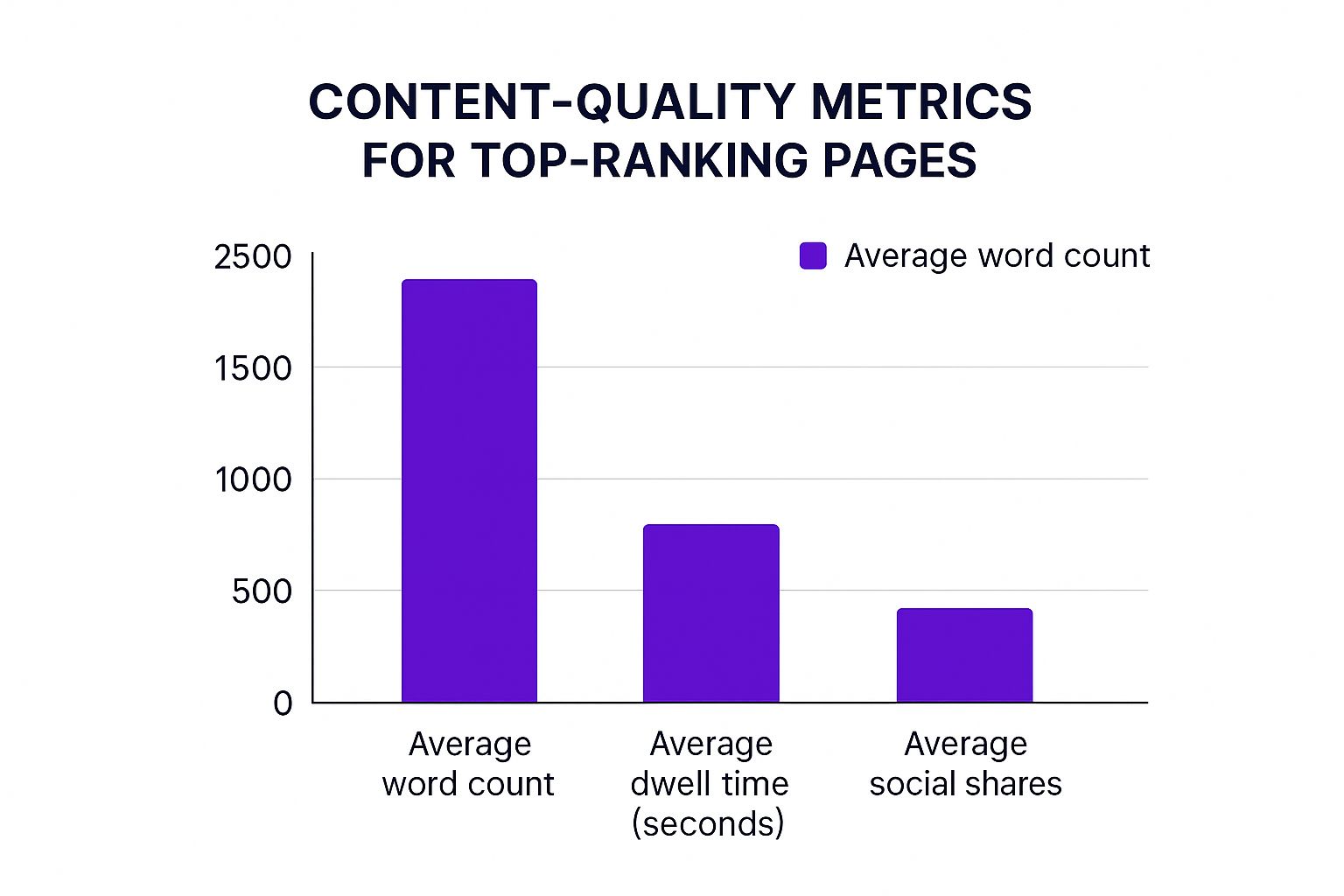
As you can see, the data clearly shows that top-ranking content tends to be more comprehensive, keeps users engaged for longer, and generates significant social validation.
The Power of Reviews and Localised Content
Customer reviews are the lifeblood of local SEO. Not only do positive reviews directly impact your visibility in the Local Pack, but the keywords people use in them are also incredibly powerful.
Recent UK-focused data shows that the relevance of keywords in reviews accounts for 11% of local ranking influence. That's even more significant than the sheer volume of reviews, which sits at 8%.
Encourage your happy customers to leave detailed reviews and always respond to them—both positive and negative. A thoughtful response shows you value feedback and are engaged with your community.
It's also worth remembering that with 72% of UK consumers now using voice search to find local businesses, optimising for "near me" searches is critical. Many of these searches are conversational. Creating locally-focused blog content that answers common questions (like "Where can I find the best coffee in Cambridge?") is an excellent strategy.
This approach not only helps your website rank but also reinforces your local authority, which in turn directly supports your GBP performance.
This table breaks down the most influential factors for local search rankings in the UK, highlighting where to focus your optimisation efforts for the greatest impact.
Key Local Ranking Factors and Their Impact
| Local Ranking Factor | Contribution to Ranking Improvement | Actionable Tip |
|---|---|---|
| Google Business Profile Signals | 36% | Fully complete every section of your GBP, including adding services, photos, and regular posts. |
| On-Page Signals | 17% | Include local keywords naturally in your website's title tags, meta descriptions, and page content. |
| Review Signals | 17% | Actively encourage customers to leave reviews and always respond to them professionally. |
| Link Signals | 16% | Build high-quality backlinks from other local businesses, directories, and community websites. |
| Behavioural Signals | 7% | Improve user experience on your site to increase dwell time and reduce bounce rates. |
| Citation Signals | 7% | Ensure your business name, address, and phone number (NAP) are consistent across all online directories. |
By concentrating on these high-impact areas, especially your Google Business Profile, you can make significant strides in your local search performance.
Adapting to Google Updates and AI Overviews
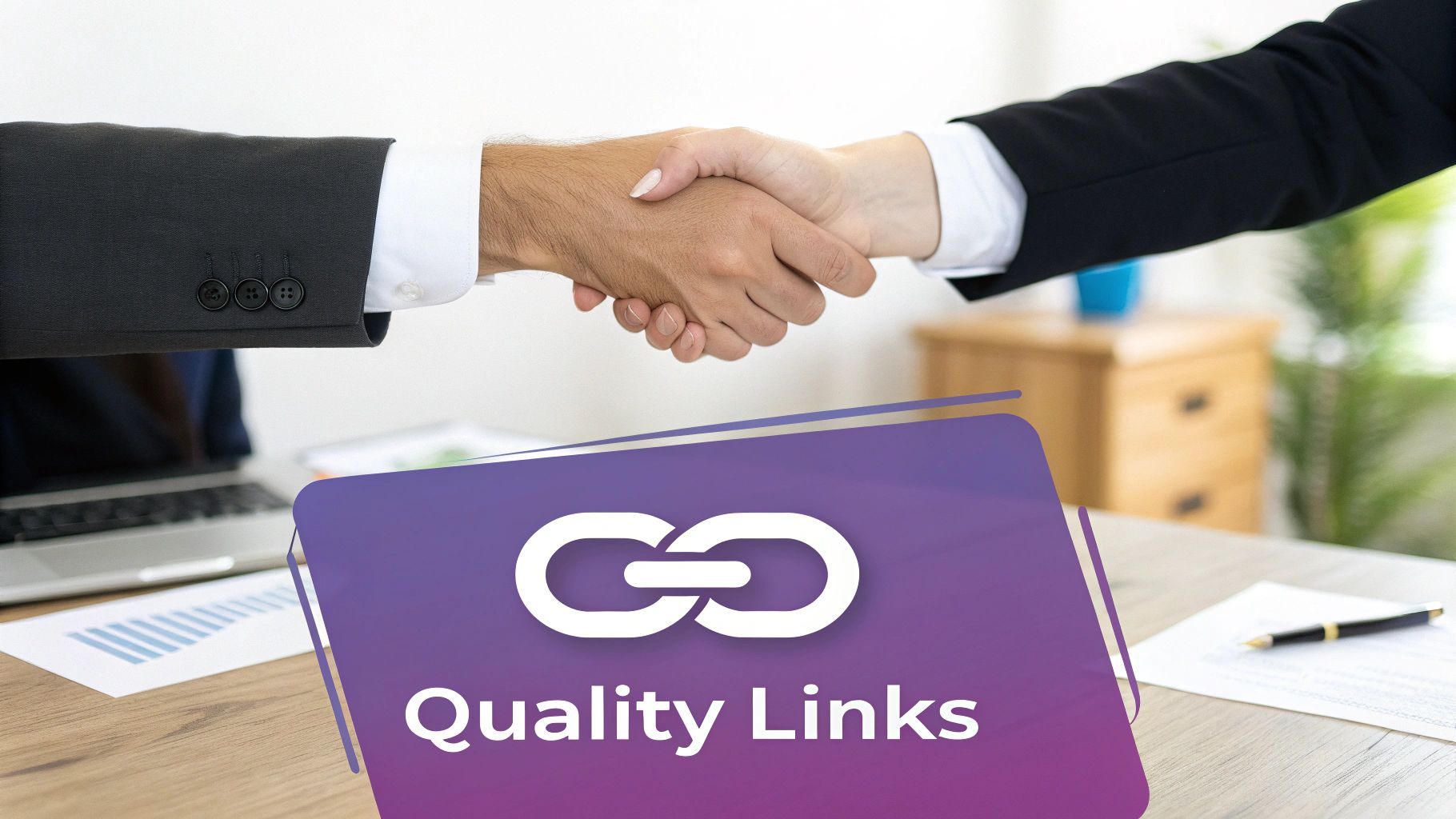
Trying to improve your Google search rankings can feel like aiming at a moving target. Just when you think you’ve got it figured out, Google refines its algorithms, rolls out a core update, or introduces something new like AI Overviews that completely reshapes the results page.
The key to long-term success isn't about finding some magic formula that works forever. It’s about building an agile strategy that can roll with the punches. When a major update hits and you see your rankings wobble, the natural reaction is to panic. Don't. The best approach is to stay informed, see how it’s actually affecting your site, and double down on the fundamentals: creating high-quality, user-focused content.
At the end of the day, Google’s goal is to give people better answers. If you align your efforts with that, you’re already future-proofing your work.
Monitoring and Interpreting Algorithm Shifts
The first step to adapting is simply knowing that a change has happened. Following reputable SEO news sources is a good start, but the real story is always in your own data. Keeping a close eye on Google Search Console and your analytics is non-negotiable.
Sudden, major drops—or spikes—in impressions and clicks are usually the first sign an update has impacted you. For example, the impact of Google’s core updates on UK search rankings can be massive and almost immediate.
After the Google Core update on 30th June 2025, we saw a huge spike in website impressions from the UK starting the very next day. Our data showed impressions doubled on 1st July and almost doubled again on 2nd July for 85% of UK-based websites we monitored, hitting both commercial and informational sites. This dramatic surge pointed to a massive reshuffle in the search results, likely driven by Google's improved localisation and the growing use of AI Overviews in UK search. You can read more on this website impressions spike in our analysis.
To make sense of these shifts, you need to:
- Segment your data: Don't just look at overall traffic. Dig deeper. Analyse performance by page, keyword, device, and country to see exactly what’s been affected.
- Analyse the SERPs: For keywords where your rankings have tanked or soared, go and do the search yourself. What kind of content is ranking now? Are AI Overviews showing up? Are there more videos?
- Check on your competitors: Have your main rivals also seen big changes? Knowing if the impact is just on your site or industry-wide gives you crucial context.
Optimising for AI Overviews and Generative Search
The rise of AI Overviews is one of the biggest changes to search in years. These AI-generated summaries sit right at the top of the results, often answering a query directly so users don't even need to click. Getting your content featured here is the new frontier for visibility.
This isn't like traditional ranking, where you're aiming for the number one spot. Google’s AI pulls information from multiple credible sources to build its answers.
Your new goal is to create content so clear, well-structured, and authoritative that Google has to use it to build a confident answer. Think of it as becoming a primary source for the AI.
To get your content ready for this, focus on clarity and structure. Use logical headings (H2s, H3s) to break down complex topics into bite-sized chunks. Answer questions directly and concisely, ideally right at the start of a section. This makes it dead simple for an AI to pull out the exact information it needs.
Building your site’s overall topical authority is also more important than ever. When your site consistently puts out in-depth, expert-led content on a specific subject, it signals to Google that you’re a trusted source. This makes it far more likely that your content will be cited in AI-generated results, turning a potential threat into a massive opportunity.
Got Questions About Improving Your Google Rankings?
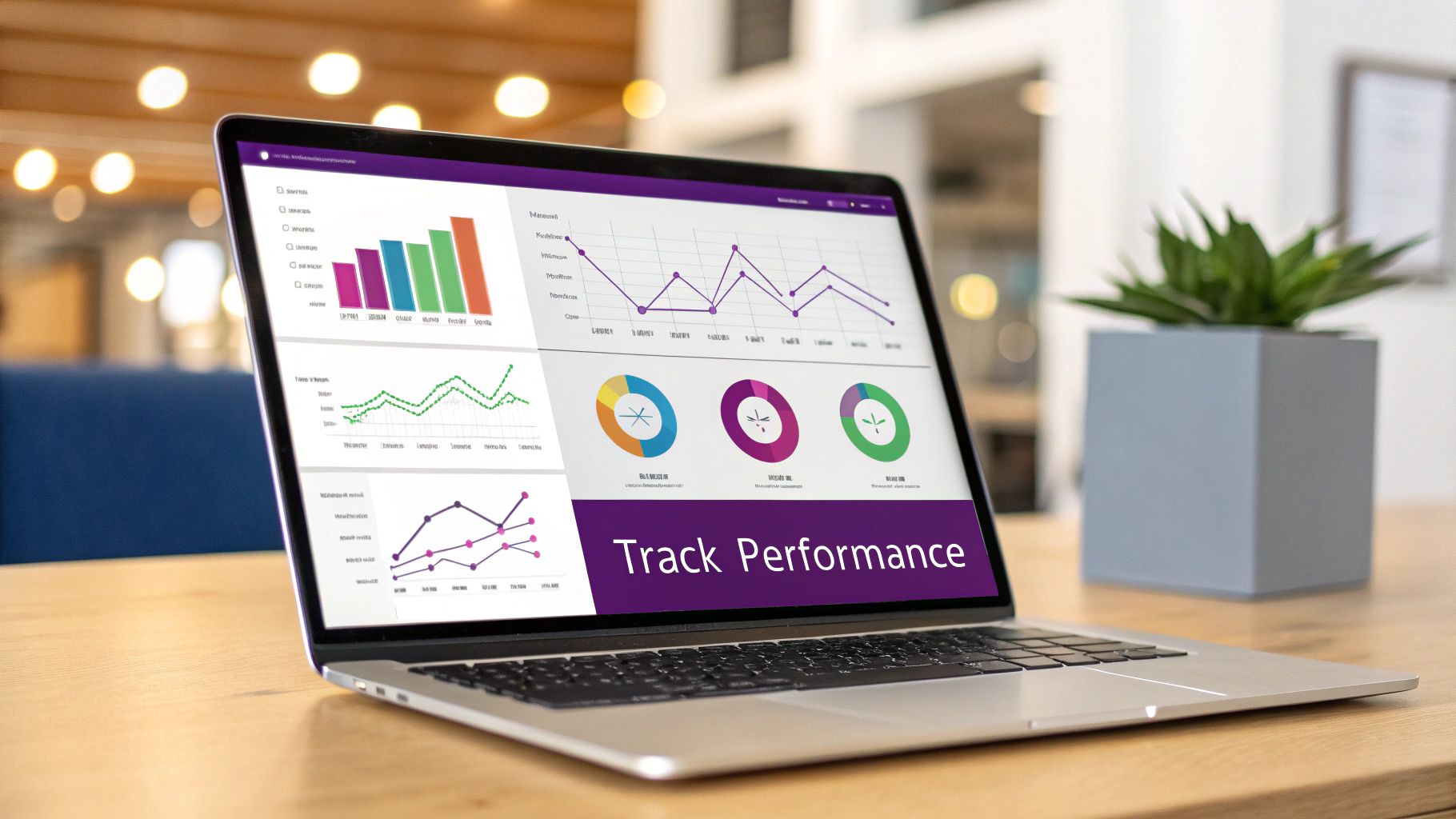
It’s completely normal. Diving into the world of SEO can feel a bit like learning a new language, and as you start putting these strategies into practice, questions about timelines, priorities, and results are bound to pop up.
Here are some straightforward answers to the queries we hear most often.
How Long Does It Actually Take to See Results?
This is the big one, isn't it? The honest answer is, it varies. How quickly you see real movement in your Google rankings depends on a few key factors: your website's current authority, just how competitive your keywords are, and how consistently you're working on your SEO.
As a general rule of thumb, you might spot some encouraging signs within 3 to 6 months. But for those top-ranking spots for valuable, competitive terms here in the UK, you’re more realistically looking at 6 to 12 months—sometimes longer. Think of SEO as a long-term investment in your business, not an overnight fix.
Should I Focus on Content or Technical SEO First?
A classic chicken-and-egg question. The truth is, you can’t have one without the other. They are two sides of the same coin.
Think of your technical SEO as the foundations of a house. If they're shaky, it doesn't matter how amazing the interior design is—the whole thing is unstable. Google needs a technically sound website to crawl, understand, and index your pages properly.
But a technically perfect site with weak, unhelpful content is just as useless. It misses the entire point of search, which is to give people the answers they're looking for.
A winning strategy needs both. Your goal is to serve up fantastic, user-first content on a rock-solid technical foundation. One simply can’t perform at its best without the other.
Can I Get to Page One Without Building Backlinks?
Theoretically, maybe. If you're targeting a very obscure, low-competition keyword, you might get lucky. But for any search term that has real commercial value, it's incredibly tough. Backlinks are still one of Google's core signals for figuring out a site's authority and trustworthiness.
Creating brilliant, link-worthy content will help you earn some links organically over time, which is fantastic. However, if you want to make serious progress in a competitive market, you’ll almost certainly need a proactive, strategic approach to link building to show Google you’re a credible player.
How Do I Know If My SEO Is Working?
You need to track the right metrics—otherwise, you’re just guessing. This is where tools like Google Search Console and Google Analytics become your best friends.
Here are the Key Performance Indicators (KPIs) you should be monitoring:
- Organic Traffic: Are you getting more visitors from UK search results?
- Keyword Rankings: Where do you stand for your most important target keywords?
- Click-Through Rate (CTR): What percentage of people are clicking your link when they see it in the search results?
- Conversions: How many of those organic visitors are taking action, like filling in a contact form or buying something?
These numbers give you the hard evidence you need to see how your SEO efforts are directly impacting your bottom line.
Ready to stop guessing and start ranking? At Bare Digital, we provide a free, no-obligation SEO Health Check and a transparent Activity Plan tailored to your business. Get your custom SEO proposal today and see how our data-driven strategies can deliver measurable results for your business.

